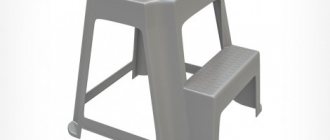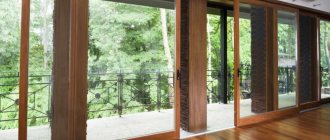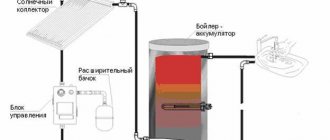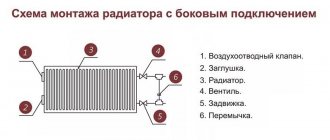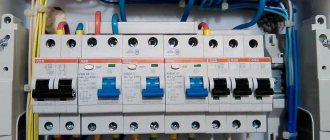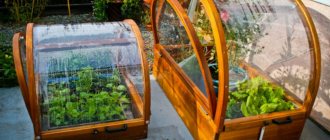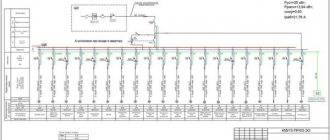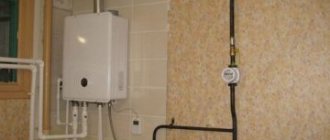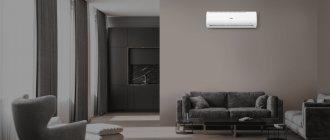The use of sanitary manifolds with shut-off valves increases the comfort of using water.
If the distribution is made with one pipe from the riser, then when several taps are opened, the water pressure in them weakens. As a result, for example, you can get burned in the shower if someone turns on the water in the kitchen.
A distribution manifold eliminates this problem. From the article you will learn more about what a water supply collector is and how to choose it.
manifold mounting
I looked through the entire section and I can’t find how to secure the collector so as not to accidentally collapse.
Look at the photos of examples of completed work, manufacturers’ catalogs. Either specialized fasteners for “steep collectors” or ordinary plumbing clamps on plumbing studs are used.
x-men wrote: Either specialized fasteners for “steep manifolds” or ordinary plumbing clamps on plumbing studs are used.
If the collector is in a metal collector cabinet, then special fasteners, otherwise - plumbing clamps on plumbing studs.
Please give me some advice: are the collectors attached correctly and can the play of the fasteners in the brick wall affect the operation of the system? (Behind the brick there is one row of emptiness). Thank you.
Dmitry wrote: are the collectors attached correctly?
Right. But everything else is not.
Use polypropylene for manifold wiring. bue.
psnsergey wrote: Use polypropylene for collector wiring. bue.
Exclusively metal-plastic? This is polypropylene with fiberglass.
As far as I understand, the choice of material is related to the number of hidden connections from the collector to the consumers? Or something else?
Dmitry - yes. Number of connections and ease of installation.
Dmitry wrote: As far as I understand, the choice of material is related to the number of hidden connections from the collector to the consumers? Or something else?
Here's what's about it
AlexMax wrote: Number of connections and ease of installation.
Well, the installation is almost complete. I hope that the connections are soldered securely, especially in places that will be hidden by tiles.
Interpreter, respected Technician-san, in his review, missed the flexible copper KME Q-tec and flexible corrugated steel. They, too, seem to already exist and are walled up. I don’t mention any joint ventures at all. The statements of Technician-san for MP are true for them.
By the way, information on composite pipes (glass fiber reinforced polypropylene)
Dmitry, that's all bullshit. Press - yes, it gives a gain, but all these PP pipes. When using drill stripping, virtually no time is lost; much more time is gained by proper labor planning and clear phasing in carrying out the planned work. But you can't teach this.
AlexMax wrote: Dmitry, that's all bullshit. Press - yes, it gives a gain, but all these PP pipes.
What can you say about the reliability of the system “in general” in this design? Is it worth (and how) to additionally mount the collector where there is a gap from the wall?
Here's the big picture: [
Dmitry wrote: Is it worth (and how) to additionally mount the collector where there is play from the wall?
Yes, it's worth it. The collectors, judging by the appearance, are Grandini? If possible, attach it to the console, at least from Hilti. To prevent it from dangling, take a smaller clamp. a half-inch will do. Collectors for 34?
AlexMax wrote: Yes, it's worth it. The collectors, judging by the appearance, are Grandini? If possible, attach it to the console, at least from Hilti. To prevent it from dangling, take a smaller clamp. a half-inch will do. Collectors for 34?
Tiemme manifolds 3/4 (3*16 + 4*16) x 2 pcs. (art. 1866N160404, 1866N160404):
The console also needs to be attached to the brick - and it’s not entirely solid. There are gaps behind the brick where the dowels with spacers fit.
Dmitry wrote: Is it worth (and how) to additionally mount the collector where there is play from the wall?
It's worth attaching anyway. Everything has to be tough. and I’m bothered by the pipe coming from the meter from the MP under the press, where does it go?
AlexMax wrote: the pipe coming from the meter from the MP under the press is straining, where does it go?
If you are talking about the white pipe that runs along the wall to the left (from the lower HB meter), this is a temporary “snot” for collecting water and flushing the “repair” toilet.
Greetings! I wanted to create a topic, but here is just a similar one. The question arose: I wanted to attach FAR 3/4 collectors (two in series with 3 and 4 pins, almost like in the photo of the vehicle
) to the plumbing wall with 3/4 clamps. However, when I secured the clamps between the outlets, this completely blocked the possibility of connecting pipes to the outlets, since the nut there no longer rotated, and if I attached the clamp at the end, it did not stay there - it fell off. Bends are planned with kofulso pipes, while temporary flexible hoses. So the question is, how to secure them to these clamps so that this does not interfere with the connection of consumers?
Video master class “Distribution manifold”
Recently, the use of a complete set of distribution and mixing unit components has become widespread. For example, a condensing boiler feeds a system of only heated floors of a small area. Such a system is quite capable of being controlled through a temperature sensor, control valves and boiler equipment. And it often turns out that the mixing unit is not needed at all or even gets in the way, and errors and illiterate assembly result in large costs. If the use of such a decoupling for a heated floor is justified in most cases, then it is needed only at elevated coolant temperatures and the joint use of high-temperature heating devices. As always, the main thing is to have a good understanding of the issue, or to entrust it to reliable people.
Collector advantages:
1. Convenient All communications are located in this place. For example, there is no need to crawl under the sink to turn off a faucet in which the faucet axle is faulty. This is especially true if there is only one pregnant woman or children left at home. It will be enough to close the required tap on the collector.
2. Reliably One solid pipe goes from the collector to the consumer without connections. In the case of a high-quality pipe, leaks in sealed walls are excluded. (although if during tee wiring the connections were, for example, made of polypropylene (soldering), then a leak is also impossible)
3. No pressure drops In the case of manifold wiring and the presence of operating pressure, there are almost completely no pressure drops when using, for example, two sinks at the same time.
Moreover, you can limit the water supply to each consumer. True, if a manifold with valve taps is installed. You can limit the water supply, for example to the toilet, if the pressure in the system is too low. And the fact that the toilet will fill 2 or 3 times slower than when fully open will not affect anything.
Water distribution combs will effectively regulate its pressure
Every housewife has encountered such a problem as a decrease in pressure in the water supply system during the simultaneous operation of several points. This problem is solved using a distribution manifold. Among consumers, they are better known as water supply combs. This wiring scheme is considered the most effective and in demand these days. This engineering solution is quite complex, but has a number of advantages.
Flaw:
1. Expensive Dilute water using collectors is much more expensive in terms of material and work if you invite a specialist. Here it is worth adding the cost of the collectors themselves, the additional footage of the pipes and, most importantly, it is necessary to provide a place where to place all this.
This is what the collector wiring looks like in a new bathroom in a private house. The pipes were subsequently sewn up.
This collector has shut-off valves for each outlet. Non-separable ball valves are installed on the bends. By the word “not dismountable” we should understand that if one of the taps fails, they cannot be replaced individually; the entire manifold is replaced. (Or part of it from thread to thread)
In these collectors, we only have the opportunity to open or close the outlet. Adjusting with such taps will not lead to anything good.
The same cannot be said about manifolds with valve and control shut-off valves.
Collectors are available with 2, 3 and 4 outlets. I have never met anyone else. Collectors for the required number of outputs are assembled from those available on the market. For example, as in the next photo, a collector with 5 outputs is made. 3+2
They are connected to each other through threads. They are sealed either with a rubber gasket as in the photo above (there is a rubber O-ring at the end of the thread) or with other sealants, such as flax.
Collectors may be different. With and without shut-off valves. With valve valves and ball valves. For thread or Eurocone.
It doesn’t matter at all what kind of pipe you use to distribute water, the collector will fit all types of pipes.
The most important thing is not to save money when buying a collector. If funds are limited, then give preference to tee wiring rather than buying low-quality manifolds, which may subsequently leak.
Example of a tired manifold on compression fittings:
If you look from right to left, you can see a small hole on the second tap and between the third and fourth.
The manifold was replaced with a new composite of 2 parts with crimping Eurocones under the MP.
Before laying pipes from a manifold, it is worth considering carefully to ensure that the pipes do not pass through areas where there is the potential for drilling into walls and floors to install walls or appliances.
Using this image as an example, you can see that the pipes are not all nearby, but are separated in groups. These are the places on the wall where the installation for the wall-hung toilet should be fixed.
Subsequently, during finishing, the collector is hidden in a special hatch. Hidden from prying eyes. (another object)
Let's see what's hidden behind this door:
If you look closer, you will see that each tap is signed and can be closed at any time. Convenient access to taps, filters and meters.
Main manufacturers
Some people pay little attention to this aspect. Confident that the design is simple, they do not think about the fact that over time, water supply collectors fail. Each of them will need repair or replacement. The only question is how soon this will happen, and how often problems will arise. Now there are several “whales” on the plumbing market:
- Far (Italy).
Despite the fact that the products of this company can be classified as a budget segment, the quality is very acceptable. The products are reliable, easy to use, unpretentious, and durable.
- Rehau (Germany).
The price of this product is higher, but the consistent German quality allows you to use the products of this company for a long time. The brass from which the structural elements are made can withstand aggressive environments, does not rust or rot.
- Tiemme (Italy).
The products belong to the middle price segment, which has made them popular among professionals, developers, and contractors. Low cost combined with reliability are the main characteristics of collectors of this brand.
- Luxor (Italian).
The main advantage is the use of innovative technologies in production. Each product is tested for functionality before leaving the assembly line. Material: brass.
- UNI-FITT (Italian).
The company produces a full range of components with which you can install a supply or heating system. The range is constantly expanding, and now there are more than 1000 items.
It's easy to get confused about manufacturers and models. To make the right choice, there are a number of recommendations that guide professionals.
Tee and manifold pipe distribution in an apartment - installation diagrams
Will tee or collector distribution of water supply pipes in an apartment be better? In order to answer this question, you should not only carefully study the installation principle in both cases, but also evaluate the pros and cons of each option. Comparing the features of installation and operation with the conditions of a specific facility (house or apartment) will allow you to make the optimal choice. The importance of choice cannot be underestimated - the ease of use of water supply systems (hot and cold), durability and maintainability of communications depends on it.
Famous brands
Valtec is an Italian manufacturer of a line of products for constructing water supply systems. A full range of products for metal-plastic, polypropylene water supply and stainless steel systems is always on sale. In Russia, representative offices are located in 6 cities, including Moscow, St. Petersburg, and Krasnodar.
Rehau is a German manufacturer with a history dating back to 1948. Products undergo multi-stage quality control.
Far (FAR) is another Italian company. In addition to shut-off and distribution valves, the line includes metal-plastic, polypropylene, copper and steel pipes.
Tee circuit and its features
Technically, the tee scheme for distributing water supply in an apartment is a serial connection - one pipe departs from the riser, to which plumbing and other water-consuming equipment are connected using tees.
The advantages of such a system are:
- economical (with a series connection, a minimum number of pipes is required),
- ease of installation.
The tee scheme for distributing water supply in an apartment also has its disadvantages:
- a large number of connections and serial connection make it difficult to find leaks,
- there is always a risk of pressure drops in the system and a decrease in pressure at the points furthest from the riser when several taps are turned on simultaneously,
- if it is necessary to carry out repair work, a complete shutdown of the water supply will be required, which represents a certain inconvenience,
- Installing tees is not always convenient in small spaces.
An example of a tee water supply wiring diagram.
Tee water supply diagrams are recommended for small apartments . With a small number of consumption points and their location close to each other, many disadvantages become less relevant - in this case it is much easier to coordinate water consumption, which means the risk of pressure loss is minimized.
When installing a tee circuit, the tees are often hidden in the walls or under the floor, which complicates inspection of communications, and during repairs inevitably leads to damage to the finish.
How to choose
Having an idea of the principle of operation of the collector, let's consider what to look for when choosing a device.
The modern market is diverse, with models for heating systems, heated floors, installation of a water supply network and the inclusion of additional components. When choosing a distributor, the installer must clearly understand the number of water consumption points, as well as the type and material of water pipes , since collectors should be chosen from the same material.
Collector circuit
The collector distribution of water supply pipes in the house makes it possible to connect a large number of consumption points, including those located at a distance from the riser. The collector circuit is a parallel connection - each element (faucet, shower, toilet, bidet, etc.) is connected to the collector using an individual outlet equipped with a valve.
The advantages of the collector circuit are:
- constant pressure regardless of the number of plumbing fixtures turned on,
- easy detection of faults on each individual line,
- high reliability of communications due to the small number of connections in the system,
- the ability to shut off the water on the line requiring repair and maintain the ability to use other lines at the same time (for example, while repairing a shower, you can wash dishes, wash your face, etc.),
- collector wiring connection lines are easily hidden in boxes, niches, etc., ensuring an attractive appearance of the premises.
Collective distribution of water supply pipes in an apartment also has its disadvantages:
- its implementation requires a larger number of pipes,
- installation of parallel connections is more complex (if you plan to do it not yourself, but with the involvement of specialists, the complexity directly affects the cost of services).
Collector layout of water supply pipes in an apartment
Collector layout of water supply pipes in an apartment allows you to optimize the operation of each device included in its composition. Filters or pressure regulators can easily be installed on individual outlets in accordance with the characteristics of water-consuming equipment and its requirements for operating conditions.
Varieties
To decide which type of collector is suitable for a room (apartment, office, store), the material of the pipelines is determined, since the methods of installing collectors are different, and not all distributors can switch to plastic pipes. It is also recommended to pay attention to the material of the product, which affects its cost.
Materials for making collectors:
- brass (possibly nickel plated);
- stainless steel;
- polypropylenes;
- cross-linked polyethylene.
Making a comb with your own hands
Although economically this is not very justified, with the necessary tools and a lot of patience, you can make a polypropylene comb yourself. To do this you will need the following materials:
- hacksaw and soldering iron for polypropylene;
- pieces of polypropylene pipe with a diameter of 25 and 32 mm;
- tees 32x25x32;
- plugs for 32nd diameter;
- couplings with internal threads 32:1 inch and 25:34;
- couplings with external threads 25:34;
- sealant;
- Ball Valves;
- air extractor.
You can do without an air extractor. But be sure to leave space at both ends to connect additional devices to the water supply comb in the future. During welding, it is important to “by eye” check the quality of the seams in order to prevent completely welded elements.
Video on how to make and install a cold water distribution comb yourself:
Recommendations for choosing wisely
The main difficulty lies not only in the installation of the collector itself, but also in the correct choice of equipment.
When choosing a comb model, you should focus on the following parameters:
- Maximum permissible pressure for this model. It determines the type of material from which the hydraulic valve can be made.
- Node throughput.
- Availability of auxiliary devices.
- Number of comb outlet pipes. It must correspond to the number of cooling circuits.
- Possibility of additional connection of elements.
All operational parameters are indicated in the product passport.
To install floor-by-floor independent heating circuits equipped with autonomous control, combs must be installed on each floor of the house.
When selecting and installing floor distributors, they are guided by the parameters of the “subsystem” that they are intended to serve.
Thanks to the floor-by-floor arrangement of the combs, if necessary, you can always turn off the heating of both several individual devices and the entire floor
This greatly simplifies the maintenance and repair of the heating system.
Since a collector block is not a cheap pleasure, in order to protect yourself from disappointment when the system quickly fails, when choosing a model, you should focus on products from trusted manufacturers.
You can safely trust such manufacturers as GREENoneTEC , Rehau , Soletrol , Oventrop and Meibes . In each series of leading European manufacturers you can select a complete set of necessary additional equipment.
Auxiliary elements and fittings for the collector block must also comply with GOST and TU.
As additional devices for connecting the manifold, you may need: 1 – automatic air vent, 2 – adapter, 3 – corner, 4 – tap, 5 – squeegee, 6 – another corner, 7 – pipe outlets
Each of the additional structural elements performs its own function:
- automatic air vent - installed if the unit and radiators are located on the same floor;
- adapter - required when installing an air vent with a diameter of ½ inch, provided that the manifold thread is ¾ inch.
- corner - will allow you to connect the pipes and direct the air vent upward.
- tap – necessary to connect the pipe coming from the boiler to the device;
- a squeegee equipped with a cap nut will allow, if necessary, to shut off the coolant supply and, by unscrewing the cap nut, disconnect the device.
If you intend to connect a water heated floor from the collector, you will additionally need to install a tap for refilling.
To fix the collector to the wall, you will also need clamps mounted on plastic dowels. When installing the structure, it is also permissible to use special brackets.
Such designs are convenient in that the upper manifold in them is pushed forward, so that the pipes of the unit do not interfere with the pipeline supply to the lower manifold.
Products on the market
The catalogs of accessories for collector water supply systems provide a wide variety of not only combs, but also their components.
- Dividers without taps are much cheaper. They allow you to assemble a device that will best suit the object. This option is preferable, as it allows you to easily replace only the failed faucet. While the one-piece design will require complete replacement.
- Devices with shut-off valves greatly simplify the installation of a water supply collector. They simplify the assembly of the unit - there is no need to install taps.
- Accessories allow you to adapt the system according to your wishes: valves, pump groups, plugs, valves, brackets, couplings, ends, servos, fittings.
- Manifold cabinets are sold separately, which are mounted into the wall and provide an aesthetic appearance, as well as access to the engineering unit.
